Hydration and Air Travel: The Dos and Don'ts of Bringing A Water Bottle on a Plane
In today's fast-paced world, air travel has become an essential means of transportation for both business and leisure purposes. As such, understanding the ins and outs of airport security rules and regulations is crucial for a hassle-free journey. One question that often arises among travelers is, "Can you bring a water bottle on a plane?" In this comprehensive article, we will delve into the intricacies of carrying water bottles on flights, the reasoning behind the regulations, and tips on how to stay hydrated while flying.
The importance of staying hydrated during air travel cannot be overstated, as dehydration can lead to fatigue, headaches, and other discomforts that can significantly impact your trip. However, navigating airport security with a water bottle can be tricky due to the strict rules in place to ensure the safety and security of all passengers. This article will provide a clear understanding of the policies surrounding water bottles at airports, the Transportation Security Administration (TSA) guidelines for carrying liquids, and the restrictions on bringing water bottles onboard a flight. Additionally, we will explore eco-friendly alternatives for staying hydrated while flying, as well as useful tips on how to easily comply with airport security measures without compromising your well-being. By being well-informed about these regulations, you can ensure a smooth and enjoyable travel experience, whether you're a seasoned globetrotter or an occasional vacationer.
Understanding Airport Security Policies and TSA Guidelines for Liquids

Airport security has come a long way since its inception, with modern policies and procedures being designed to maintain the safety of passengers, crew, and aircraft. One key aspect of airport security is the regulation of liquids, which includes water bottles. The Transportation Security Administration (TSA) is responsible for implementing these rules in the United States, and similar organizations exist worldwide.
The TSA has established guidelines known as the 3-1-1 rule for carrying liquids, aerosols, gels, creams, and pastes in carry-on bags. According to this rule, passengers are allowed to bring containers holding 3.4 ounces (100 milliliters) or less per item, with all containers fitting into a single, quart-sized, clear, resealable plastic bag. This bag must be presented separately from other belongings during the security screening process.
While these restrictions may seem inconvenient, they were put in place following an attempted terrorist attack in 2006, when liquid explosives were discovered on a transatlantic flight. The small container size limit is designed to minimize the potential threat posed by liquid explosives, while still allowing passengers to bring essential items on board.
In light of these guidelines, bringing a full-sized water bottle through airport security is not permitted. However, there are alternatives and strategies you can use to stay hydrated while flying, which we will discuss in the following sections.
Eco-friendly Alternatives and Tips for Staying Hydrated During Air Travel
As environmental consciousness grows, many travelers seek eco-friendly alternatives to disposable plastic water bottles. One such option is to bring an empty reusable water bottle through airport security. Once you have passed the security checkpoint, you can fill your bottle at a water fountain or ask a restaurant or cafe within the terminal to fill it for you. This not only reduces plastic waste but also ensures that you have access to water throughout your journey.
Another option is to purchase a collapsible water bottle, which can be easily packed in your carry-on bag and filled once you are through security. These bottles are lightweight and take up minimal space, making them an ideal choice for travelers.
In addition to carrying a reusable water bottle, consider the following tips to stay hydrated during air travel:
💠Avoid excessive consumption of caffeine and alcohol, as these substances can contribute to dehydration.
💠Consume water-rich foods such as fruits and vegetables as part of your inflight meal or snacks.
💠Keep a balanced electrolyte intake by consuming sports drinks or electrolyte tablets, particularly on long-haul flights.
💠Set reminders on your phone or watch to drink water at regular intervals during the flight.

Complying with Airport Security Measures While Prioritizing Hydration
While it is important to adhere to airport security regulations, you should not compromise your well-being during air travel. By following the guidelines and tips outlined in this article, you can ensure that you remain hydrated while complying with the rules set forth by the TSA and other aviation security organizations.
Remember that although you cannot bring a full-sized water bottle through airport security, empty reusable bottles and collapsible options are allowed. Make it a habit to carry an empty bottle with you when traveling and fill it up once you have cleared security. This simple practice can help you stay hydrated, reduce plastic waste, and contribute to a more enjoyable and comfortable flying experience.
By being well-informed about airport security policies and adopting eco-friendly hydration practices, you can navigate the complexities of air travel with ease, ensuring a smooth and pleasant journey every time you fly.

Can you bring an empty water bottle through airport security in the United States?
Why does the TSA limit carry-on liquids, aerosols, and gels to 3.4 ounces (100 mL)?
Can you bring bottled water on a plane?
Quenching Your Thirst While Soaring Through the Skies: A Recap on Water Bottles and Air Travel
In conclusion, understanding the policies surrounding water bottles at airports and the TSA guidelines for carrying liquids is essential in ensuring a smooth and stress-free air travel experience. Although you cannot bring a full-sized water bottle through airport security, there are various eco-friendly alternatives and strategies that can help you stay hydrated while adhering to the rules set forth by aviation security organizations.
By bringing an empty reusable or collapsible water bottle, you not only reduce plastic waste but also prioritize your well-being during your journey. Remember to avoid excessive consumption of caffeine and alcohol, consume water-rich foods, and maintain a balanced electrolyte intake to further support your hydration needs.
Staying informed about airport security measures and adopting sustainable practices for hydration contributes to a more enjoyable and comfortable flying experience for both seasoned globetrotters and occasional vacationers alike. So, the next time you embark on an adventure, keep these tips in mind and ensure that you remain refreshed and hydrated as you soar through the skies.
Thanks for reading & safe travels!
Ky & J
Related Reads:

The Ultimate Hydration Guide & Top-Notch Water Bottles!

How Many Bottles of Water Should You Drink a Day?

Sip in Style with Top 10 Best Glass Water Bottles In 2023!





